How to use the Finance Dashboard
The Finance Dashboard uses a smart tiles to alert finance reps to projects and clients that need their attention and gives them access to reports such as paid deposit invoices pending production and clients on credit hold.
This article explains how finance reps can use their Finance Dashboard to track their team's tasks.
Users need permission to "View Finance Menu" to use the Finance Dashboard.
On this page:
How to use your Dashboard's smart tiles
How to submit suggestions to make the Finance Dashboard more useful
Key terms
Budget: A project's estimated revenue, entered on the project overview.
Client rep: The salesperson who manages the client's account, usually known as the account manager or account executive.
Closed: A canceled sale or a sales form that did not result in business (the client did not place an order).
Converted: A sales form that has moved to the next sales stage. For example, a sales rep may convert a presentation to an estimate or sales order.
Credit hold:
In production: A project that has a sales order and purchase orders. A sales order's status automatically changes to In Production when a rep creates the supplier purchase orders.
Open: A sales form is Open when the sales rep is still working on it. For example, a presentation is Open when a sales rep uses it to send product ideas to their client. If the client decides not to place an order, the sales rep should change the presentation's status to Closed. If the client chooses to place an order, the sales rep will convert the presentation to an estimate or sales order.
Pre-sale: A preliminary sales form, like a presentation or estimate, or any sales-related activity before creating an actual sales order, like a new sales opportunity.
Ready to be invoiced:
Revenue: Total sales income, not including tax.
Sales forecast: Estimated revenue.
Value: An estimate, sales order, or invoices subtotal.
How to create a new project from your Finance Dashboard
- Click New Project in the top right corner.
- Select a pre-existing client from the drop-down list, or click + New Client at the bottom of the drop-down to add a new client to commonsku
- If you are adding a new client (optional):
- Type the client's name
- Select their industry from the drop-down menu
- Click Create Client
- If you are adding a new client (optional):
- Enter a Project Name
- Select an Event Type from the drop-down
- Select your Starting Stage
- Click Continue
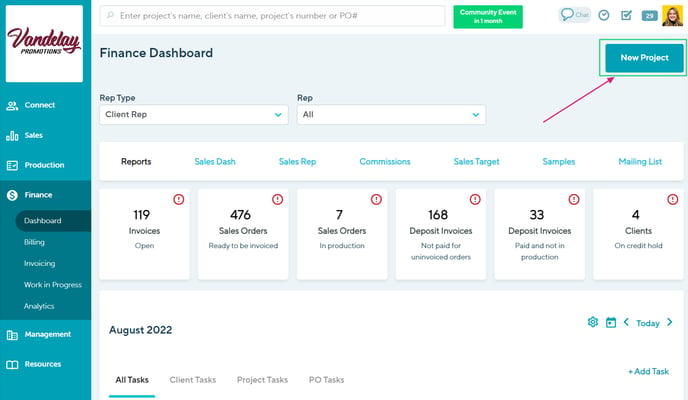
How to use your Dashboard's smart tiles
The Dashboard's smart-tiles increase efficiency by alerting invoicing reps to invoices that need their attention and alleviating the burden of monitoring multiple reports.
The Finance Dashboard includes actionable tiles, like:
- Open Invoices
- Sales orders ready to be invoiced
- Sales orders still in production
- Unpaid deposit invoices
- Paid deposit invoices for orders not in production
- Clients on credit hold
Open invoices
The Open Invoices tile tracks invoices based on the invoice status (Open). This alert tile displays invoices that haven't been sent to the client, exported, to account, or paid.
How to use the Open invoices tile:
- Click into the tile to open a list of open invoices
- Filter the invoices by selecting different column titles (for example, click on the "Stage" column to filter the results by stage)
- Click on the hyperlinked project name or number to be redirected to the project
- Select any project to open a slide-out menu with more details and action items, like completed or pending action items (tasks). From the slide-out menu, you can:
- Update the form's status, the project's in-hands date, budget, and assigned reps
- create and manage any related tasks
- Click the Actions button to view either the project or the client's page.

Sales orders ready to be invoiced
The Sales orders ready to be invoiced tile tracks sales orders based on the order's status (Ready to be Invoiced). This alert tile displays orders that have completed production and are ready for invoicing.
How to use the Sales orders ready to be invoiced tile:
- Click into the tile to open a list of sales orders ready to be invoiced
- Filter the invoices by selecting different column titles (for example, click on the "Stage" column to filter the results by stage)
- Click on the hyperlinked project name or number to be redirected to the project
- Select any project to open a slide-out menu with more details and action items, like completed or pending action items (tasks). From the slide-out menu, you can:
- Update the form's status, the project's in-hands date, budget, and assigned reps
- create and manage any related tasks
- Click the Actions button to view either the project or the client's page.
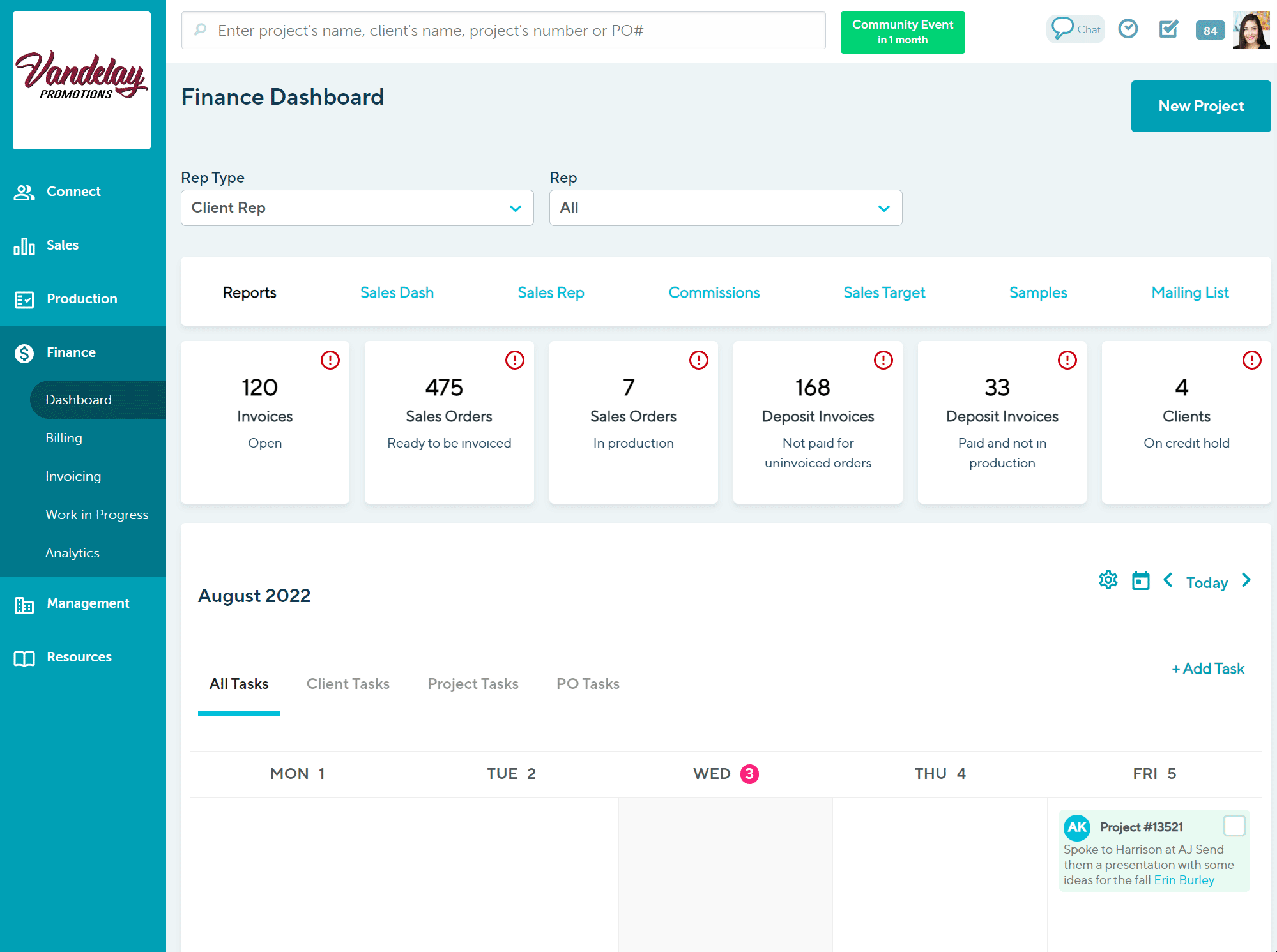
Sales orders still in production
How to use the Sales orders still in production tile:
- Click into the tile to open a list of sales orders still in production
- Filter the invoices by selecting different column titles (for example, click on the "Stage" column to filter the results by stage)
- Click on the hyperlinked project name or number to be redirected to the project
- Select any project to open a slide-out menu with more details and action items, like completed or pending action items (tasks). From the slide-out menu, you can:
- Update the form's status, the project's in-hands date, budget, and assigned reps
- create and manage any related tasks
- Click the Actions button to view either the project or the client's page.

Unpaid deposit invoices
The unpaid deposit invoices tile displays outstanding deposit invoices.
How to use the unpaid deposit invoices tile:
- Click into the tile to open a list of unpaid deposit invoices
- Filter the invoices by selecting different column titles (for example, click on the "Client" column to filter the results by client)
- Click on the hyperlinked sales order number, client name, or project name or number to be redirected to the order or client
- Select any project to open a slide-out menu with more details and action items, like completed or pending action items (tasks). From the slide-out menu, you can:
- Update the form's status, the project's in-hands date, budget, and assigned reps
- create and manage any related tasks
- Click the Actions button to view either the project or the client's page.
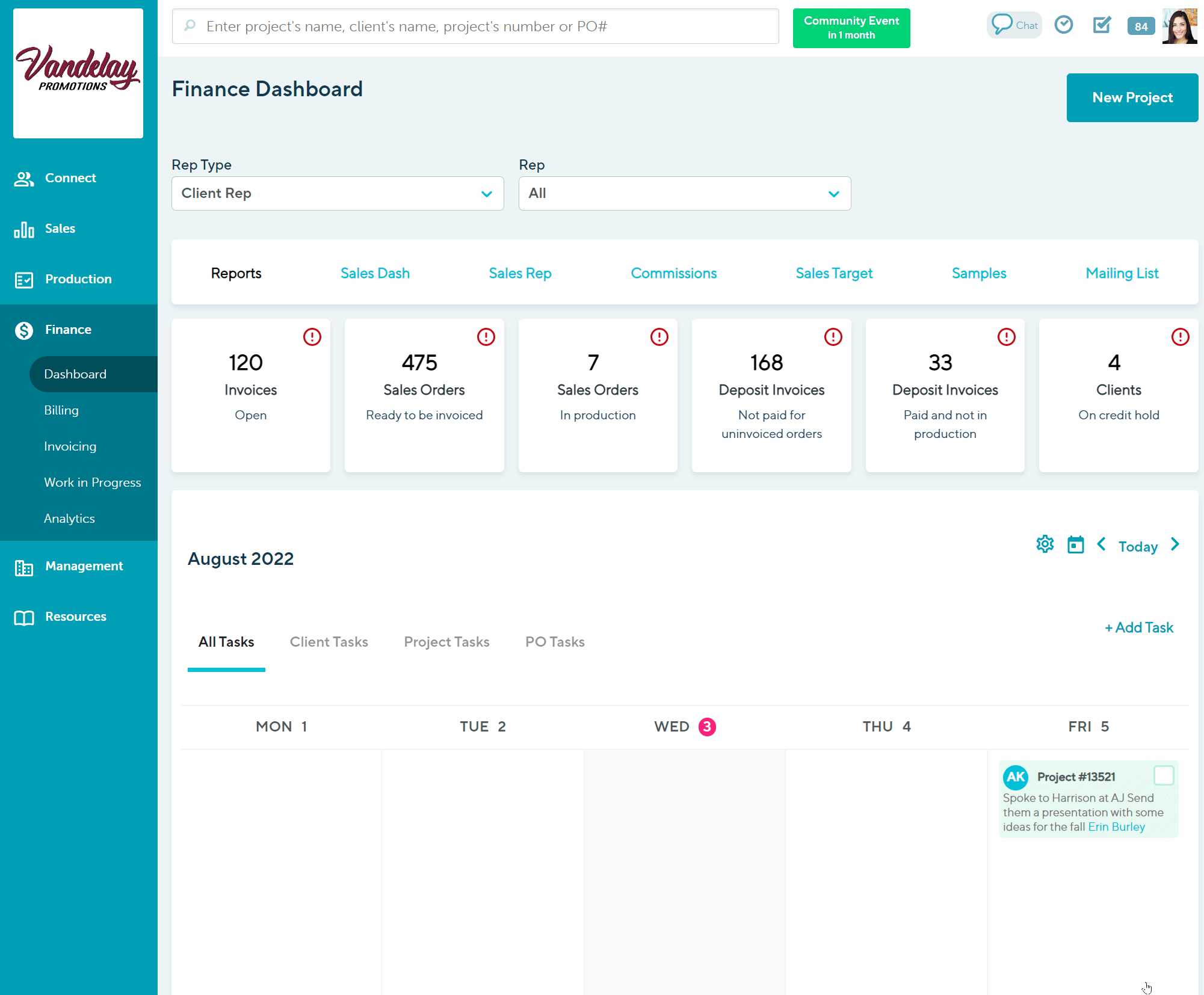
Paid deposit invoices for orders not in production
The Paid deposit invoices for orders not in production tile displays paid deposit invoices for an order that hasn't been moved into production.
How to use the Paid deposit invoices for orders not in production tile:
- Click into the tile to open a list of Paid deposit invoices for orders not in production
- Filter the invoices by selecting different column titles (for example, click on the "Client" column to filter the results by client)
- Click on the hyperlinked sales order number, client name, or project name or number to be redirected to the order or client
- Select any project to open a slide-out menu with more details and action items, like completed or pending action items (tasks). From the slide-out menu, you can:
- Update the form's status, the project's in-hands date, budget, and assigned reps
- create and manage any related tasks
- Click the Actions button to view either the project or the client's page.
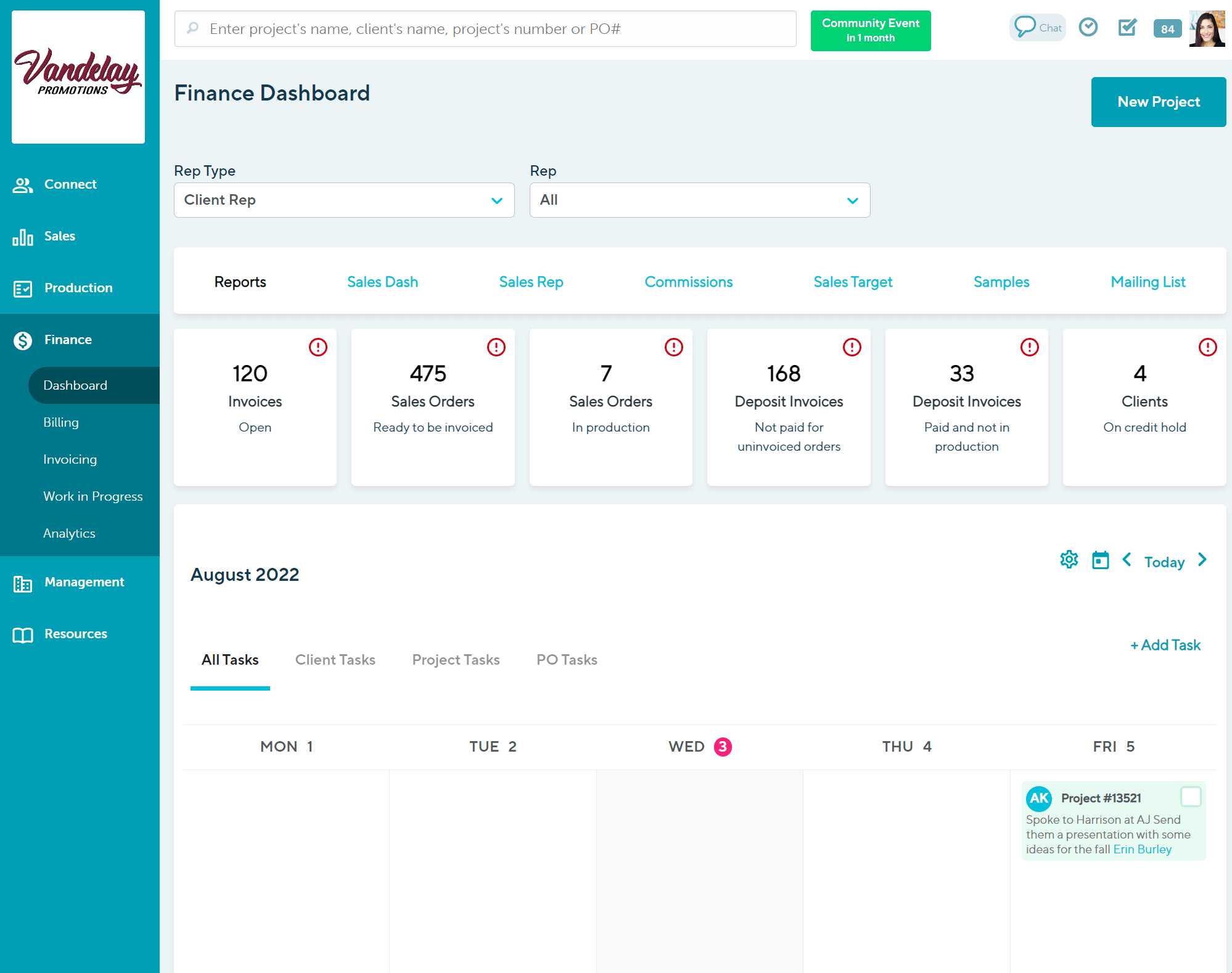
Clients on credit hold
The Clients on credit hold tile highlights clients placed on a credit hold (no more client status workarounds!)
How to use the Clients on credit hold tile:
- Click into the tile to open a list of Clients on credit hold
- Filter the invoices by selecting different column titles (for example, click on the "Rep" column to filter the results by rep)
- Click on the hyperlinked client name to be redirected to the client's profile
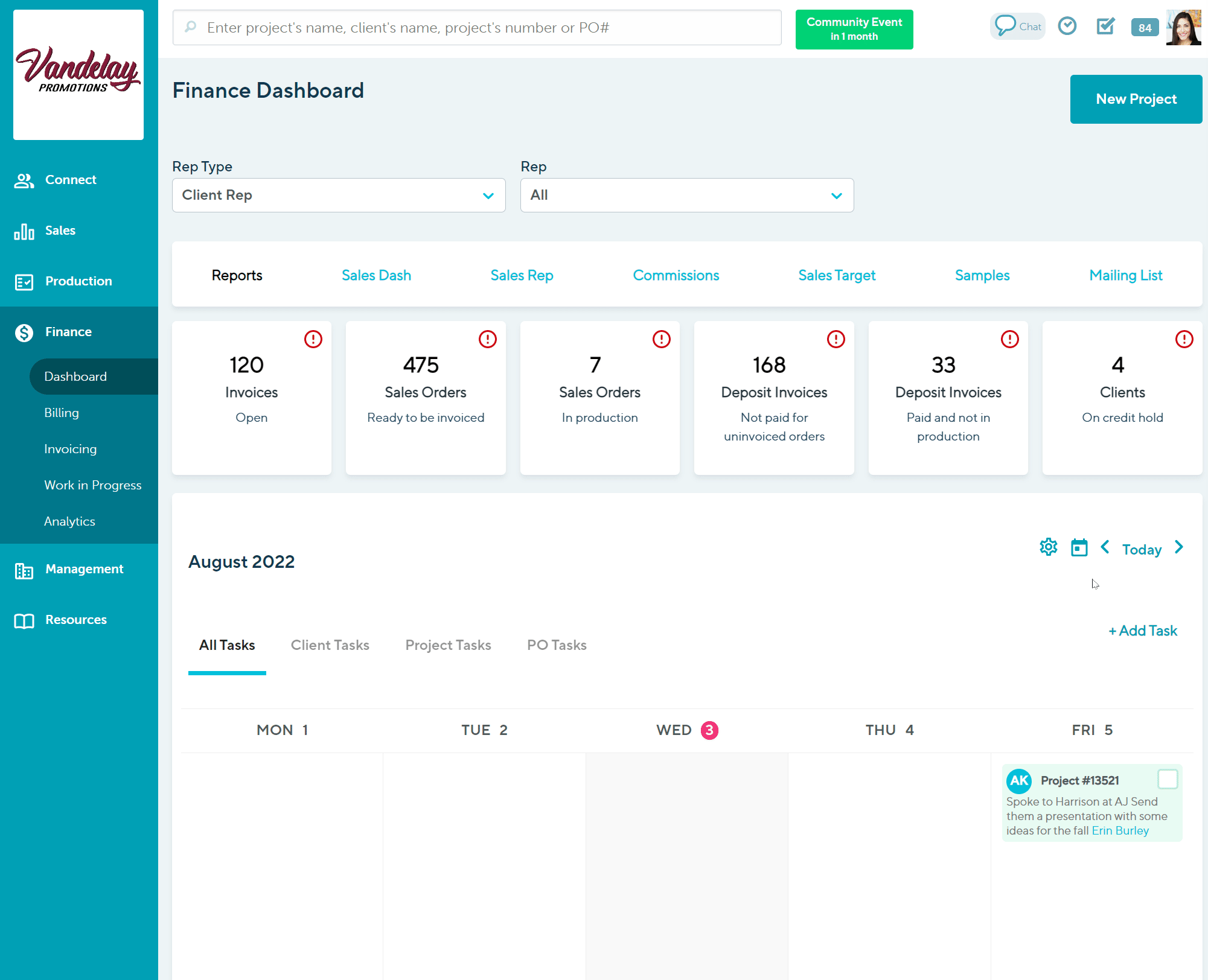
How to use the reports
The Finance Dashboard provides quick links to the following reports:
- Sales Dashboard Report
- Sales Rep Report
- Commission Report
- Sales Target Report
- Sample Report
- Mailing List Report
How to manage your tasks
Finance reps can use the Finance Dashboard's date-driven task panel to visually manage their tasks and stay focused on what's most important.
The tasks panel shows a weekly view of pending and completed tasks, separated into four categories:
- All tasks
- Clients tasks (tasks set on a client's page)
- Project tasks (tasks assigned in a project's overview)
- Overdue tasks (outstanding tasks with a due date prior to the current week)
Tasks are also separated into three colors:
- Green tasks show upcoming tasks that are due today or at a future date as well as tasks that were completed in the calendar week
- Red tasks show overdue tasks that have not been completed
- Grey tasks show completed tasks - completed tasks will automatically move to the bottom of the (daily) task list and fade from green or red to grey.
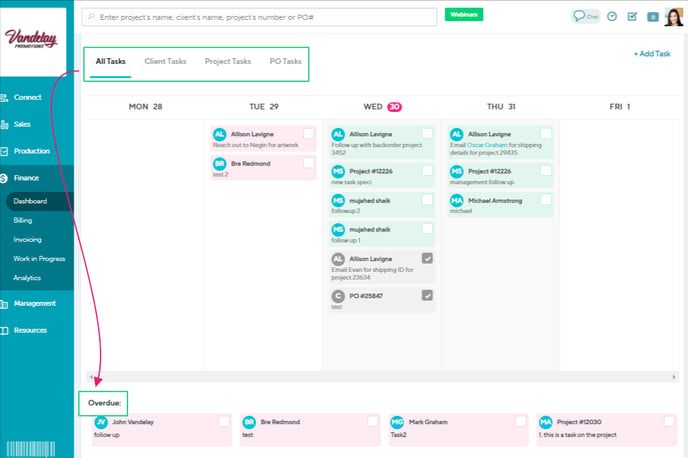
Learn how to:
- View a task
- Edit a task
- Comment on a task
- Mark a task as being completed
- Delete a task
- Add a new task
- Add weekends to your task panel
- View past and upcoming tasks by week
How to view a task
The task panel's overview displays tasks due within the present week (Mon-Sun). It shows when a task is due, who it is assigned to, and where it was created.
To view additional task details:
- Click into the task to open a slide-out menu to reveal the task's details and any comments
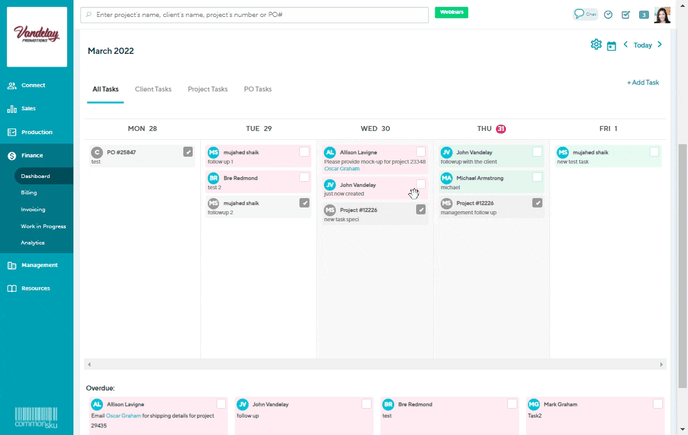
How to edit a task
To edit a task:
- Click into the task to open the slide-out menu
- Click into the current tasks text, date, or rep down-down and update as needed
- Click the Close button (unless you are adjusting the text field, then click the Save button)
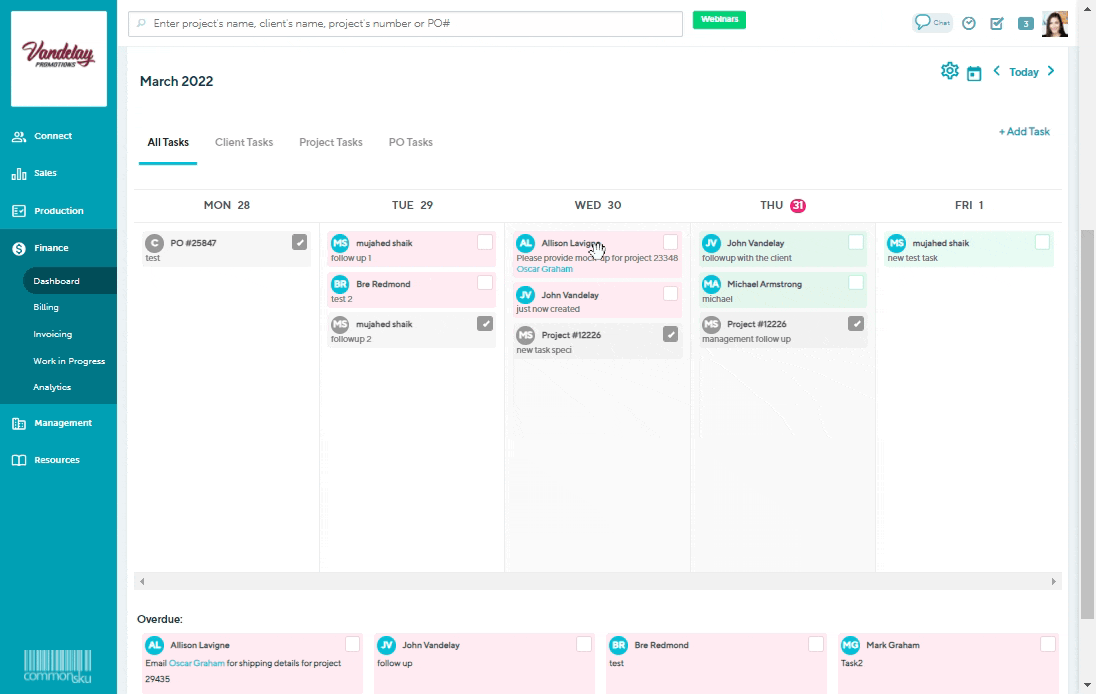
You can even drag-and-drop a task to change its due date!
How to comment on a task
To comment on a task
- Click into the task to open the slide-out menu
- Click into the current tasks text, date, or rep down-down and update as needed
- Click the Save button
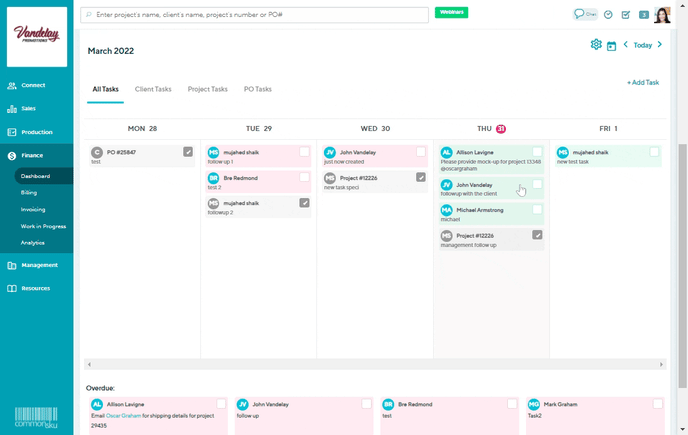
How to mark a task as being completed
To complete a task
- Locate the task you'd like to complete and select the checkbox to the right
Completed tasks will automatically move to the bottom of the (daily) task list and fade from green or red to grey.
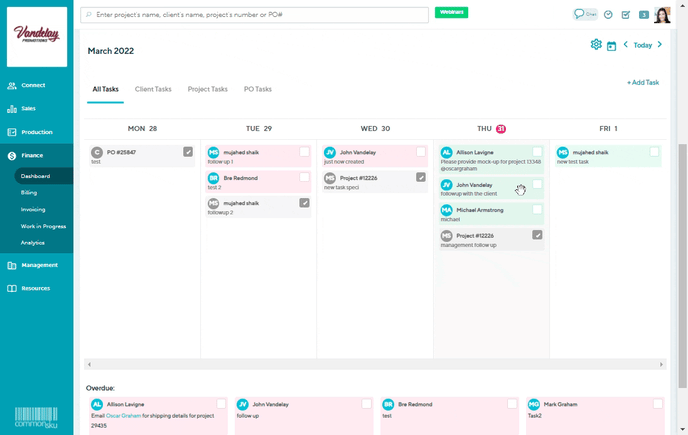
How to delete a task
To delete a task:
- Click on the task to open the slide-out menu
- Click the Actions button > Delete Task
- Click OK in the browser confirmation pop-up

Only the user who created the task will be able to delete it.
How to add a new task
To add a new task:
- Click the + Add Task button in the top right corner of the task panel
- Enter the task details
- Click Post
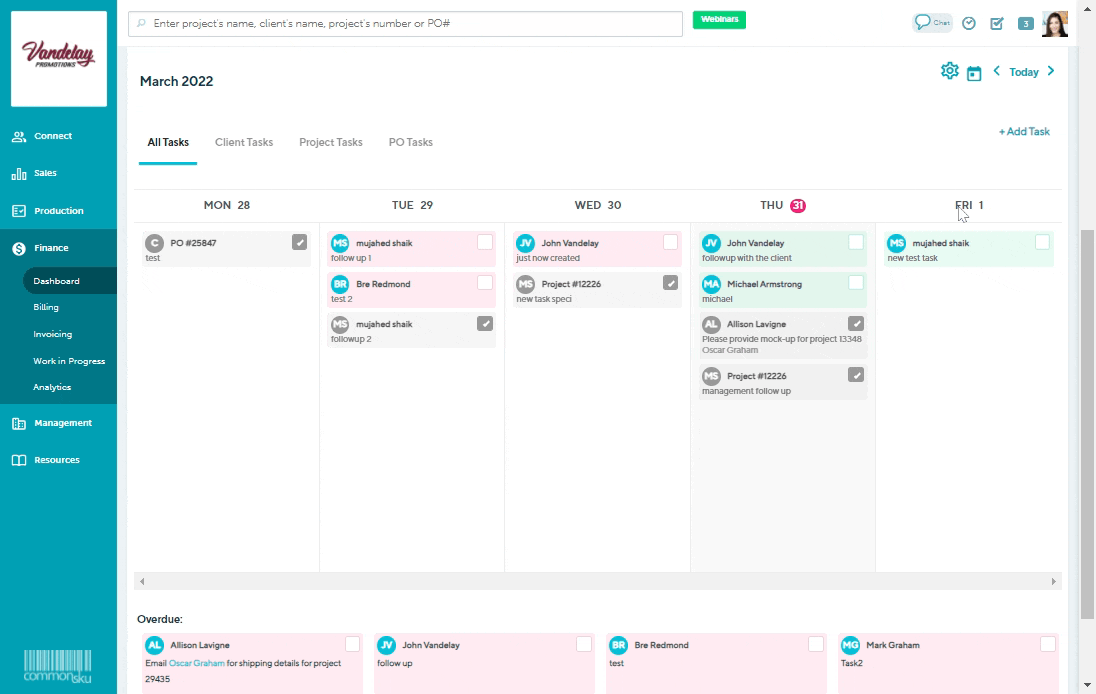
How to add weekends to your task panel
By default, the task panel displays tasks due within the present week (Mon-Fri).
To add weekends to your task panel:
- Click the settings icon on the top right corner of the task panel
- Select the checkbox beside "Weekends"
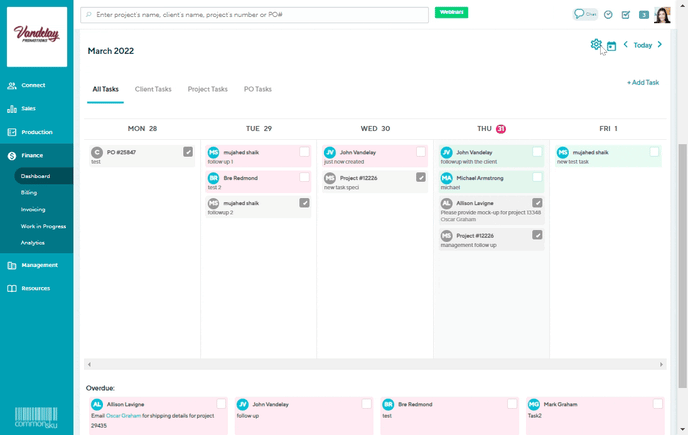
How to view past and upcoming tasks by week
To change the week displayed on your task panel:
- Click the left arrow in the top right corner of the task panel to view past weeks, or click the right arrow to view upcoming weeks
- Click the Today button to jump back to the present week's tasks

How to submit suggestions to make the Finance Dashboard more useful
Do you have a suggestion that will make our Dashboards or Analytics pages more useful? We'd love to hear from you!
To send your feedback:
- Click the "Got an Idea?" button at the top of your Finance Dashboard
- Enter your email address, company name, choose the navigation section and page your suggestion applies to
- Type your feedback in the "Feedback/Suggestions" text box
- Click Submit